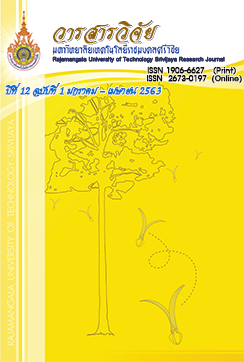The Effect of Organic Fertilizer Formula from Sajor-caju Mushroom (Pleurotus sajor-caju) Waste on Macronutrients
Keywords:
organic fertilizer, sajor-caju mushroom waste, macronutrientsAbstract
The objective of this research was to study five organic fertilizer formulas of the Sajor-caju mushroom (Pleurotus sajor-caju) waste with the highest macronutrients (N, P, K) after fermentation and the highest portion of Sajor-caju mushroom waste. The five levels of Sajor-caju mushroom wastes (50%, 60%, 70%, 80% and 90%) were mixed with five levels of chicken dung and cow dung (50%, 40%, 30%, 20% and 10%). The results found that organic fertilizer formula of the Sajor-caju mushroom waste with the highest macronutrients after fermentation and the highest portion of Sajor-caju mushroom waste was the second formula which contained 2.28%, 2.63% and 3.82% of N, P, and K, respectively. 60% of Sajor-caju mushroom waste was used. Also, it is classified in the high-quality organic fertilizer due to the Department of Land Development.
References
AOAC. 2000. Official Methods of analysis of the association of official analytical chemists (17th ed). Washington, DC.
Brummer, V., Jecha, D., Lestinsky, P., Skryja, P., Gregor, J. and Stehlik, P. 2016. The treatment of waste gas from fertilizer production - An industrial case study of long term removing particulate matter with a pilot unit. Powder Technology 297: 374-383.
Chiang, P.N., Tong, O.Y., Chiou, C.S., Lin, Y.A., Wang, M.K. and Liu, C.C. 2016. Reclamation of zinc-contaminated soil using a dissolved organic carbon solution prepared using liquid fertilizer from food-waste composting. Journal of Hazardous Materials 301: 100-105.
Hoffman, N., Singels, A., Patton, A. and Ramburan, S. 2018. Predicting genotypic differences in irrigated sugarcane yield using the Canegro model and independent trait parameter estimates. European Journal of Agronomy 96: 13-27.
Innes, R. 2013. Economics of Agricultural Residuals and Overfertilization: Chemical Fertilizer Use, Livestock Waste, Manure Management, and Environmental Impacts, pp. 50-57. In Shogren, J.F., ed. Encyclopedia of Energy, Natural Resource, and Environmental Economics. Elsevier, Waltham.
Jiang, Y., Ju, M., Li, W., Ren, Q., Liu, L., Chen, Y. and Liu, Y. 2015. Rapid production of organic fertilizer by dynamic high-temperature aerobic fermentation (DHAF) of food waste. Bioresource Technology 197: 7-14.
Meena, M.D., Joshi, P.K., Jat, H.S., Chinchmalatpure, A.R., Narjary, B., Sheoran, P. and Sharma, D.K. 2016. Changes in biological and chemical properties of saline soil amended with municipal solid waste compost and chemical fertilizers in a mustard-pearl millet cropping system. CATENA 140: 1-8.
Mondal, T., Datta, J.K. and Mondal, N.K. 2017. Chemical fertilizer in conjunction with biofertilizer and vermicompost induced changes in morpho-physiological and bio-chemical traits of mustard crop. Journal of the Saudi Society of Agricultural Sciences 16 (2): 135-144.
Onnby, L., Harald, K. and Nges, I.A. 2015. Cryogel-supported titanate nanotubes for waste treatment: Impact on methane production and bio-fertilizer quality. Journal of Biotechnology 207: 58-66.
Rajoka, M.I. and Malik, K.A. 1997. Cellulase production by Cellulomonas biazotea cultured in media containing different cellulosic substrates. Bioresource Technology 59(1): 21-27.
Raza, W., Wei, Z., Ling, N., Huang, Q. and Shen, Q. 2016. Effect of organic fertilizers prepared from organic waste materials on the production of antibacterial volatile organic compounds by two biocontrol Bacillus amyloliquefaciens strains. Journal of Biotechnology 227: 45-53.
Silva, V. N., Silva, L.E.S.F., Silva, A.J.N., Stamford, N.P. and Macedo, G.R. 2017. Solubility curve of rock powder inoculated with microorganismsin the production of biofertilizers. Agriculture and Natural Resources 51: 142-147.
Tampio, E., Marttinen, S. and Rintala, J. 2016. Liquid fertilizer products from anaerobic digestion of food waste: mass, nutrient and energy balance of four digestate liquid treatment systems. Journal of Cleaner Production 125: 22-32.
Tejada, M., Rodríguez-Morgado, B., Gómez, I., Franco-Andreu, L., Benítez, C. and Parrado, J. 2016. Use of biofertilizers obtained from sewage sludges on maize yield. European Journal of Agronomy 78: 13-19.
Tejada, M., Rodríguez-Morgado, B., Paneque, P. and Parrado, J. 2018. Effects of foliar fertilization of a biostimulant obtained from chicken feathers on maize yield. European Journal of Agronomy 96: 54-59
Downloads
Published
How to Cite
Issue
Section
License
The content and information in the article published in Journal of Rajamangala University of Technology Srivijaya It is the opinion and responsibility of the author of the article. The editorial journals do not need to agree. Or share any responsibility.







